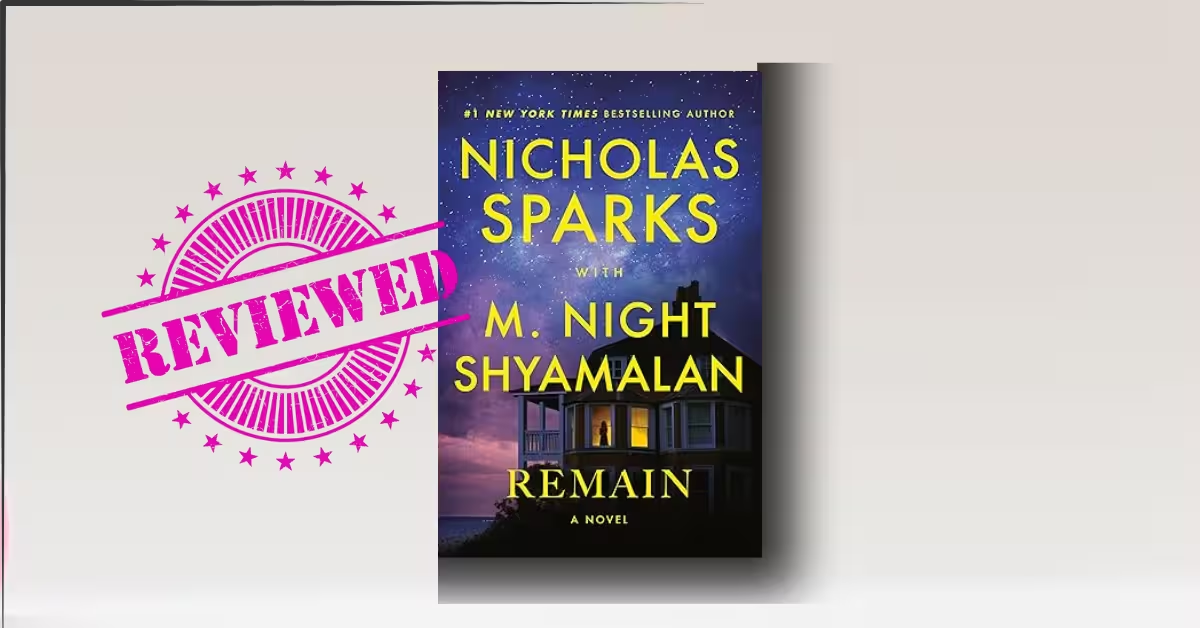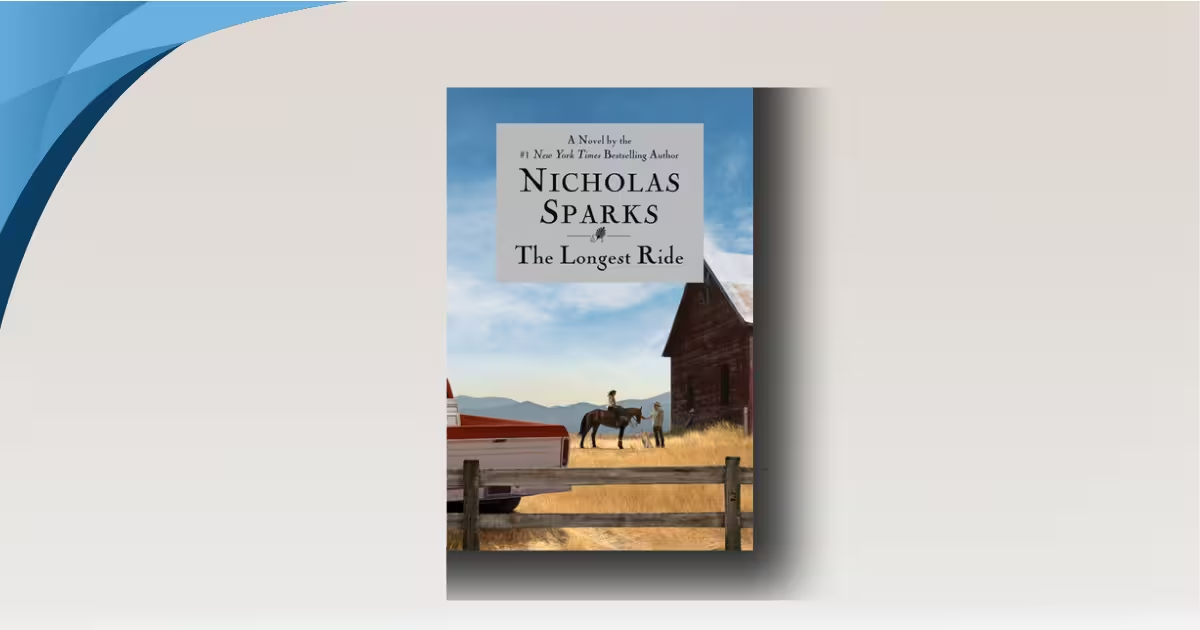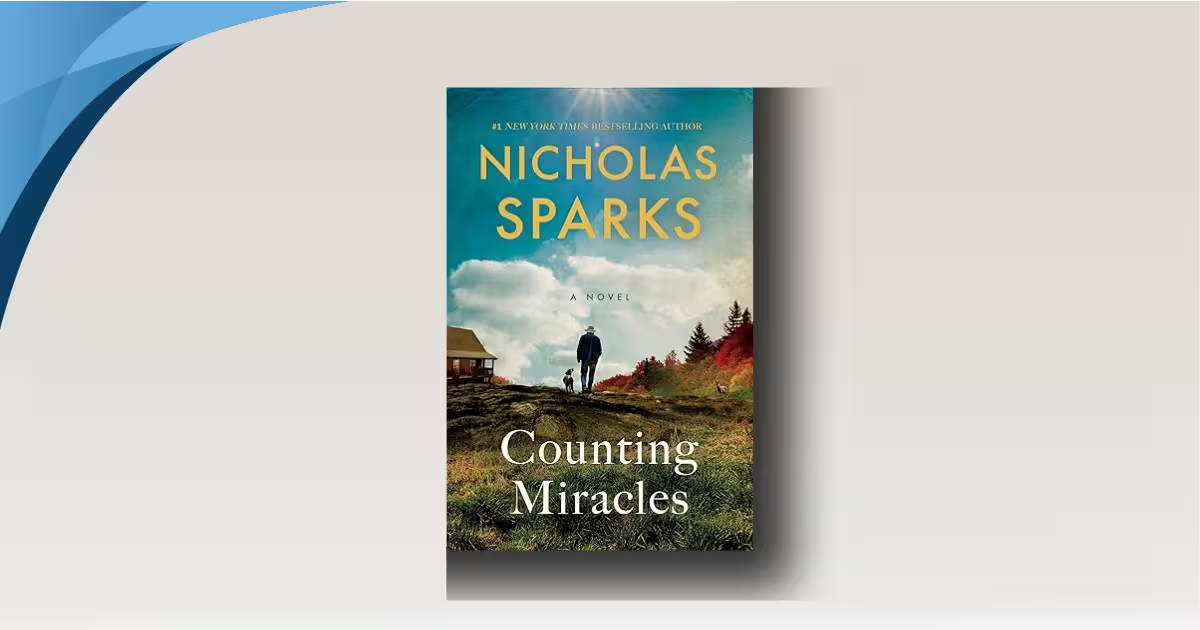Grief scrambles memory and meaning; love promises to reorder both. Remain solves a pain almost everyone knows: how to live through loss without letting go of the one you lost.
A burned-out New York architect retreats to Cape Cod and falls for a woman who is both irresistible and impossible—forcing him to decide what it means to love someone who can’t quite stay.
Official listings confirm Remain as a 2025 collaboration between Nicholas Sparks and M. Night Shyamalan, published in October 2025 (352 pp.), with a film adaptation in development; early reviews and community ratings are already live.
Best for / Not for. The book is best for readers of supernatural romance who crave a weepy, eerie, architecturally precise ghost love story; not for readers who require airtight realism or unambiguously happy endings. (See comparison notes and adaptation status below.)
Table of Contents
1. Introduction
Remain: A Supernatural Love Story — Nicholas Sparks with M. Night Shyamalan (Penguin Random House, Oct. 14, 2025; 352 pages). First-edition ISBNs and catalog data appear with retailer and publisher listings; Goodreads shows early reader reception hovering around the 3.8–3.9 range.
Across decades, Sparks’ novels have sold well over 115–130 million copies worldwide, making Remain both an experiment and a culmination: a classic Sparks romance braided with Shyamalan’s supernatural unease. That mix is reflected in publisher copy (“a one-of-a-kind novel”) and interviews; a film directed by Shyamalan and fronted by Jake Gyllenhaal and Phoebe Dynevor is slated for wide release.
For context, critical coverage identifies the book’s tone as The Notebook meets The Sixth Sense: atmospheric, emotional, and ghost-tinged. Reader-side reviews echo the same—romance first, supernatural second, with a bittersweet aftertaste.
2. Background
Sparks’ brand is grief-tested devotion; Shyamalan’s is reality, tilted. Their collaboration began as a creative dare—two artists telling the same core story in different mediums—which the Wall Street Journal recaps alongside Sparks’ disciplined writing routine. The cinematic tie-in is already in motion.
Commercially and culturally, Remain drops into a post-pandemic appetite for “haunting but hopeful” fiction. Sparks’ global sales and long trail of film adaptations amplify expectations, while the Shyamalan name primes readers for reveals that reframe what came before.
Cape Cod’s literary coastline, storms and all, gives the novel a weather-true stage: shingle-style architecture, shoulder-season festivals, and small-town rumor all matter to the plot mechanics and mood (more below, with textual evidence).
3. Remain Summary
Tate Donovan, a successful architect recovering from a depressive episode and still raw from family loss, arrives in Heatherington, Cape Cod, to design a summer house for his best friend Oscar and Oscar’s wife, Lorena. He needs a reset—professionally, spiritually, even physically. Publisher and author pages summarize this premise; the text fills it with local texture—Cape Cod porches, client wish-lists, and the status anxieties that cling to “dream homes.”
Soon, Tate meets Wren Tobin—first as a presence felt more than seen, then as someone vibrant, teasing, and impossibly attuned to his grief. He notices the “luminous eyes,” the no-makeup ease, the way she stands “windblown” as if fresh from the beach; their talk settles him like a pressure valve opening. “I felt sure that I’d never met anyone quite like her before… never once did I feel judged.”
Then comes the break in reality. Oscar forces the issue with a single, brutal line: “Wren Tobin… died almost two years ago.” Tate reels, cycling through explanations—hallucination, hoax, gaslighting—refusing the ghost hypothesis because it violates everything “true and reliable.” The chapter explicitly stages this triage of rationalizations.
What follows is part love story, part investigation. Tate begins to reconstruct Wren’s last weeks: a suffocating marriage to Griffin; money and property pressure linked to a trust; a restraining-order-adjacent situation with Dax, a local counselor whose obsession curdled into stalking (“I’ve watched you at the grocery store,” he wrote, promising to “follow you into the afterlife”). That letter is arguably the book’s ugliest artifact.
The most harrowing set piece is Wren’s death reconstruction. A chapter stages the bathroom as both crime scene and memory loop: door knob turning, humming in the hall, the tub filling, the lock, the wineglass—the ordinary choreography of an evening derailed by intrusion. In Tate’s vision, the altercation escalates, hair yanked, skull striking the faucet, water rising. He wonders aloud about forensics and whether anything survives “more than two days” in water.
Claire-cold details fill in the social context: the small-town festival circuit, band dreams greased by sponsorships from Griffin’s family dealership, drugs, and volatile moods. “Anything could set him off,” Wren says; Tate notes the holes punched in drywall, the plates smashed in a rage. This is domestic terror, local-sized.
The middle third toggles between night-visitations—Wren materializing “crying” in a tub, whispering “I… couldn’t… get… away”—and daytime legwork: interviews, boxes in the shed, ledgers, photographs, and the crumpled letter from Dax. Tate keeps designing and cooking (a quiet throughline), but the home he’s really building is an answer to Wren.
As Tate closes in, motive branches: Griffin (property, money), Nash (reputation), Dax (rejection). The novel refuses courtroom certainty; instead, it asks whether “love” can coexist with obsession and whether grief can accept a truth that can’t fully be proved. Tate’s ache is physical; his desire to keep Wren is moral and metaphysical.
The ending (no cheap twist, some genuine release) honors the book’s title: to remain is not merely to stay alive, but to endure in meaning. In Sparks’ idiom, it’s love as weather—changing, returning, re-patterning the shore.
4. Remain Analysis
4.1 Remain Characters
Tate Donovan is classic Sparks: capable yet cracked, successful yet hollowed by loss. His voice toggles between professional exactitude (site plans, elevations) and amateur metaphysician (is she a ghost, a memory, a trick of grief?). Wren’s characterization bifurcates: the living woman with hobbies (music, recipes, festivals) and the posthumous presence who can still make him laugh, then vanish mid-stride. The text literalizes that vanishing—she disappears “entirely within a few steps,” then reappears breezily to resume a thought about Griffin and bands.
Secondary figures anchor the real. Oscar and Lorena ground Tate; Louise and Reece (the house’s caretakers) signal local knowledge and withholding; Nash is reputational rot; Dax is menace in cursive. Tate’s empathy compounds as he reads Wren’s documented life—childhood photos, recipe box, legal folders, and that yellow legal pad tallying “transgressions.”
This is a love story, but it’s also a character study in how communities metabolize tragedy—via rumor, routine, and the practicalities of who cleans what and when.
4.2 Remain Themes & Symbolism
Grief & Memory. Sparks often asks whether memory can be a form of devotion; Remain adds Shyamalan’s concern with perception (what did you see, really?). The bathroom is symbol and stage: a private room turned public evidence, a mirror that notices nothing, a tub that holds both self-care and death. “She’d been in the water more than two days…” Tate thinks, as if the detail itself were an accusation.
Obsession vs. Love. Dax’s letter (“I’d follow you into the afterlife”) weaponizes romantic diction; it contrasts with Wren’s lightness in everyday scenes and with Tate’s patient attentiveness. The book wants you to feel the difference in your gut.
Architecture as Ethics. Every measured line Tate draws is a counter-spell to chaos. The debate over “traditional Cape Cod or something more modern” doubles as a question about how to live after loss: repeat a form, or risk a new one?
5. Evaluation
Strengths. The romance lands (quiet, adult, cumulative). The supernatural is handled with restraint (no jump-scare fireworks). The procedural spine—letters, records, interviews— keeps pages turning. As one reviewer put it, the mash-up surprisingly works; another called it “a haunting success.”
Weaknesses. If you demand empirical closure, the ending may frustrate. Some readers find the prose plain by design—Sparks’ transparency can feel spare next to gothic atmospherics. (Early reviews split along exactly that seam.)
Impact. The book snagged me with small mercies: a Mary Oliver poem on a rough morning, a homemade dinner that tastes like competence, a sketch that becomes a promise. (“When I read the title of the poem… ‘On Death’… I wondered if these words described Wren’s confusion.”)
Comparison with similar works. Think The Notebook’s devotion crossed with The Sixth Sense’s melancholic reveal—exactly how several critics have framed it. If you liked Silvia Moreno-Garcia’s Mexican Gothic for mood or Emily Brontë’s Wuthering Heights for intensity, you’ll find kinship here, though Remain stays contemporary and coastal.
Adaptation (book → film) & Box Office. The film is in active development under Shyamalan, starring Jake Gyllenhaal and Phoebe Dynevor; release is planned for next October. Box-office figures do not exist yet (unreleased), but Sparks’s adaptations historically gross high nine figures in aggregate, which sets a realistic bar. Expect tonal differences: the novel’s ambiguity may sharpen into a clearer reveal on screen.
6. Personal Insight & Contemporary Relevance
Grief literacy is an underrated skill. The novel’s gentlest scenes model it: introducing a poem (“On Death”), cooking a meal without numbing distractions, naming what hurts without demanding a timetable. For educators, therapists, and caregivers, Remain works as a case study in continuing bonds—the idea that healthy mourning often maintains, rather than severs, a relationship with the dead (see mainstream primers from bereavement research and community resources).
7. Remain Quotes
“Wren Tobin,” Oscar says, “died almost two years ago.”
“She’d been in the water more than two days…”
“I’d follow you into the afterlife if need be.” — Dax’s letter to Wren.
“I…couldn’t…get…away…” — Wren in the bathroom visitation.
“She made a series of funny faces—puffing out her cheeks… puckering up her lips in an exaggerated kiss…” (the life that should have remained).
8. 7 Big Ideas in *Remain
1. Ghost romance that plays fair with reality
Tate’s first “impossible” encounters with Wren are written to honor rational doubt before yielding to the supernatural—he cycles through hallucination, hoax, or ghost, refusing the last because it “went against everything I knew to be true and reliable.” Oscar’s blunt reveal—“Wren Tobin… died almost two years ago”—snaps the story from flirtation into haunting.
2. Grief as an engine, not just a mood
The book shows grief activating purpose: Tate spends nights in the hallway listening for faucets and pipes, then meets Wren in the tub where she whispers, “I… couldn’t… get… away….”
Sparks/Shyamalan root the ache in bodies and forensic detail—“She’d been in the water more than two days…”—so mourning becomes investigation.
3. Cape Cod as character and clue
Heatherington is sketched with classic Cape textures—picket fences, soda shop, festival crowds—so setting isn’t wallpaper; it’s part of motive, alibis, and access. Even design talk—“traditional Cape Cod? Or something more modern?”—echoes the book’s choice between repetition (staying) and risk (moving on).
4. Love vs. obsession (and how language disguises harm)
Dax’s letter dresses stalking as destiny—“I’ve watched you… followed you… I’d follow you into the afterlife”—a textbook contrast to Tate’s patient presence. When confronted, Dax reframes events to protect himself, underscoring how abusers weaponize story.
5. The bathroom as symbol: privacy, evidence, truth
We see the scene twice: as forensic horror (blood on the faucet; towel missing) and as living memory (wineglass, lock, humming). The doubleness makes the room a hinge between life and afterlife.
Oscar’s practical question—“how did she hit the back of her head?”—pokes the hole in the accident theory.
6. Architecture as ethics (building a life that can hold sorrow)
Tate’s sketches and shingle-style choices soothe him and mirror the plot’s moral carpentry: measuring facts, checking structure, resisting showy façades. As afternoons with Wren turn weightless—“I forgot that she was a ghost at all”—design becomes devotion, the human-scale antidote to chaos.
7. Staying (to remain) becomes an action, not a state
The title resolves in behavior: Wren helps Tate escape a burning house and save Oscar—remaining as care, not clinging. “The house is on fire!… You have to save Oscar!”
In the end, love “remains” by changing shape—accepting mystery where proof fails, and choosing the living even while honoring the dead.
9. Conclusion
If your sweet spot is “weepy but weird,” Remain delivers: a supernatural love story that treats grief with respect and romance with patience. The Cape setting is textured; the clues are mundane and devastating; the final movement earns its ache. For readers who loved The Notebook but are open to a spectral tilt, this is the Sparks book you didn’t know you wanted.
Fans of domestic thrillers who need hard proof? You might bounce. Readers of romance with mystery, ghost romance, and Cape Cod fiction should move it to the top of the stack, then watch for Shyamalan’s adaptation.
Related


